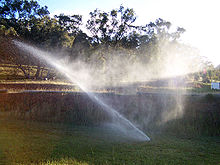Automated tank cleaning machine


An automated tank cleaning machine is a machine used to clean cargo tanks such as those found in tank trucks, railroad cars, barges, and oil tankers.[1] Genericized trademarks such as Gamajet and Butterworth machine are often used to refer to automatic tank cleaning machines regardless of their manufacturer.[2]
Operation

Tanks must be cleaned from time to time for various reasons. One reason is to change the type of product carried inside a tank.[3] Another is to allow the tank to be inspected or for maintenance to be performed within a tank.[3]
Automated tank cleaning machines work in a manner similar to an irrigation sprinkler. Hot water forced through a jet nozzle rotates the nozzle. The nozzle's rotation moves the machine through a cleaning pattern.[1] As the water sprays, the liquid is pumped out of the tank.[3] Portable water washing systems are widely used, but tanks that are cleaned frequently may have a fixed system installed.[3]
The Butterworth Type K machine is widely used.[1] This model can clean a tank of up to 10,000,000 US gallons (38,000 m3).[1] It uses water with a pressure up to 250 psi (1,700 kPa) and a temperature of up to 250 °F (121 °C).[1] The water jet reaches up to 115 feet (35 m).[1] Depending on the pressure used, a cleaning cycle can take from about 10 to 50 minutes and the machine uses between 15 US gallons (56.8 L; 12.5 imp gal) and 350 US gallons (1,324.9 L; 291.4 imp gal) per minute.[1]
On most crude-oil tankers, a special crude oil washing system, or COW system, is part of the cleaning process.[3] The COW system circulates hot crude oil through the fixed tank-cleaning system to remove wax and asphaltic deposits.[3]
Although machines are often used to wash tanks, a final stage of manual cleaning known as mucking, is usually performed.[2] Mucking requires protocols for entry into confined spaces and the use of airline respirators, protective clothing and safety observers.[2]
Tank cleaning is dangerous in a number of ways. While tank barges can be cleaned in port, shipboard tanks are generally cleaned at sea.[2] This is largely due to risks of fire and explosion inside the tanks.[2] However, with Gamajet tank cleaning machines, confined space entry is greatly reduced eliminating danger to workers. [4]
History
The first automated tank cleaning machine was invented by Arthur Butterworth and patented in 1920.[5] His goal was to limit the amount of time that workers had to spend inside tanks, and partially relieve them of a dangerous and laborious job.[5] In 1925, Butterworth established a company to market the machine.[5] Standard Oil New Jersey bought the company in 1930, and it later became a subsidiary of the Exxon Corporation.[5]
In 1986, as part of an internal restructuring at Exxon, the Butterworth company was sold to Exxon management.[5] Today the company is privately held, and headquartered in Houston, Texas.[5]
See also
Notes
- ^ a b c d e f g Butterworth, Inc., 2007
- ^ a b c d e OSHA, 2008.
- ^ a b c d e f Hayler and Keever, 2003:14-12.
- ^ Colbentz, Lindsay. "A Clean Sweep." Food Manufacturing. 20 July 2012. Web. http://www.foodmanufacturing.com/articles/2012/07/clean-sweep Retrieved 4 September 2012.
- ^ a b c d e f Butterworth, Inc., 2001, About Us.
References
- Hayler, William B.; Keever, John M. (2003). American Merchant Seaman's Manual. Cornell Maritime Pr. ISBN 0-87033-549-9.
- Huber, Mark (2001). Tanker operations: a handbook for the person-in-charge (PIC). Cambridge, MD: Cornell Maritime Press. ISBN 0-87033-528-6.
- International Chamber of Shipping (1996). International Safety Guide for Oil Tankers and Terminals (ISGOTT). New York: Hyperion Books. ISBN 1-85609-081-7.
- Occupational Safety & Health Administration (OSHA) (2008-01-30). "Process: Tank Cleaning". Shipbuilding and Ship Repair - Hazards and Solutions. Department of Labor. Archived from the original on 1 April 2008. Retrieved 2008-04-08.
{{cite web}}: Unknown parameter|deadurl=ignored (|url-status=suggested) (help) - Momber, A.W.: Hydroblasting and Coating of Steel Structures. Elsevier Applied Science, London, 2003
- Turpin, Edward A.; McEwen, William A. (1980). Merchant Marine Officers' Handbook (4th ed.). Centreville, MD: Cornell Maritime Press. ISBN 978-0870330568.
{{cite book}}: Cite has empty unknown parameters:|origmonth=,|chapterurl=, and|origdate=(help) - Occupational Safety & Health Administration (OSHA) (2008-01-30). "Process: Tank Cleaning". Shipbuilding and Ship Repair - Hazards and Solutions. Department of Labor. Archived from the original on 1 April 2008. Retrieved 2008-04-08.
{{cite web}}: Unknown parameter|deadurl=ignored (|url-status=suggested) (help) - Butterworth, Inc. (2001). "About Us". Butterworth Tank Cleaning Systems. Butterworth, Inc. Retrieved 2008-04-09.
- Butterworth, Inc. (2001). "Butterworth Tank Cleaning Machines". Butterworth, Inc. Archived from the original on 31 March 2008. Retrieved 2008-04-09.
{{cite web}}: Unknown parameter|deadurl=ignored (|url-status=suggested) (help) - Butterworth, Inc. (2007-01-14). "Tank Cleaning Machine, Type K/SK/SSK" (PDF). Product Data Sheets. Butterworth, Inc. pp. 1–2. Retrieved 2008-04-09.
- Savage, K. M. (December 1973). "Marine Gas Hazards Control: Cleaning and Gas-Freeing Shipboard Tanks . National Institute for Occupational Safety and Health (NIOSH) Contract Report 099-74-0002 (NTIS PB-82-225-095)". Proceedings of the International Shipyard Health Conference.
- Gamajet Cleaning Systems, Inc. (2003-07-15). "Frequently Asked Questions". Gamajet Cleaning Systems, Inc. Retrieved 2008-04-09.
